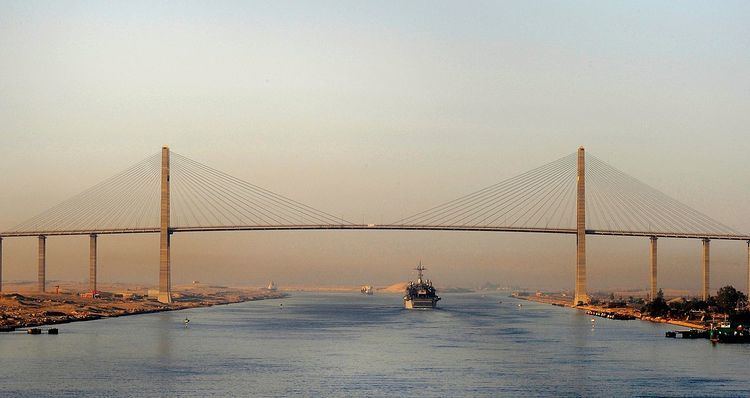Carries vehicular traffic Locale El Qantara, Egypt Opened 9 October 2001 Height 154 m Location El Qantara, Egypt | Construction started 1995 Clearance below 70 m Total length 3,900 m | |
 | ||
Owner General Authority for Roads, Bridges & TransportMinistry of Transport and Communication Maintained by General Authority for Roads, Bridges & Transport, Ministry of Transport and Communication Design Cable-stayed bridge semi-fan arrangement, H-pylon, hollow box Similar El Ferdan Railway Bridge, Ahmed Hamdi Tunnel, Port Said Lighthouse, 6th October Bridge, Wadi El Gamal National | ||
Suez canal bridge from the bow of the uss dwight d eisenhower
The Mubarak Peace Bridge, also known as the Egyptian-Japanese Friendship Bridge, Al Salam Bridge, or Al Salam Peace Bridge, is a road bridge crossing the Suez Canal at El Qantara. ("El Qantara" means "The Bridge" in Arabic.) The bridge links the continents of Africa and Eurasia.
Contents
- Suez canal bridge from the bow of the uss dwight d eisenhower
- Map of Al Salam Bridge Al Qantarah Sharq Ismailia Governorate Egypt
- Egypt plan to build first suez canal bridge to link africa with asia
- Design and construction
- Significant developments in the region
- References
Map of Al Salam Bridge, Al Qantarah Sharq, Ismailia Governorate, Egypt
Egypt plan to build first suez canal bridge to link africa with asia
Design and construction
The bridge was built with assistance from the Japanese government. The main contractor was Kajima Corporation.
The Japanese grant, accounting for 60% of the construction cost (or 13.5 billion yen), was agreed to during the visit of then-President Mubarak to Japan in March 1995, as part of a larger project to develop the Sinai Peninsula. Egypt bore the remaining 40% (9 billion yen). The bridge was opened in October 2001.
The bridge, which has a 70-metre (230 ft) clearance over the canal and is 3.9 kilometres (2.4 mi) long, consists of a 400-metre (1,300 ft) cable-stayed main span and two 1.8-kilometre (1.1 mi) long approach spans.
The height of the two main pylons supporting the main span is 154 metres (505 ft) each. The towers were designed in the shape of Pharaonic obelisks.
The clearance under the bridge is 70 metres. Therefore, the maximum height of ships that can pass through the Suez Canal (Suezmax) is 68 metres above the waterline.
Significant developments in the region
The Suez Canal Bridge was part of a major drive to develop the areas surrounding the Suez Canal, including other projects such as the Ahmed Hamdi Tunnel under the Suez Canal (completed in 1981), the El Ferdan Railway Bridge, and the Suez Canal overhead powerline crossing.
